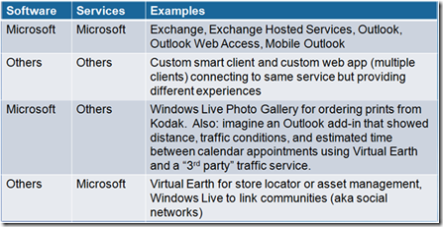Microsoft's Software + Services strategy in 10 minutes or less...
I got an email recently asking me to present Microsoft's Software + Services strategy at an internal Microsoft meeting recently. The challenge: keep it under 10 minutes. After the session it occurred to me that a lot of folks might get something out of an "Software + Services (S+S) in a nutshell" kind of post. So here it is: The essence of S+S in about 10 minutes:
S+S is a big deal. Like the Windows PC in the early 90's, the web in the mid-90's, and .NET around the turn of century, S+S is a major movement in computing. It's the most significant architecture change of the last half-decade.
The core idea of S+S is that all the technology platforms should work well together. That is, Software plus Services working together. A rough, shorthand definition for the Services part of S+S is "capabilities from the cloud". This is sometimes call SaaS for Software-as-a-Service, and has been getting a lot of buzz. The attention is warranted: the web really has become a platform for building and delivering solutions. That's relatively new and very important.
While the web has indeed become a platform, it is not the only platform. The traditional software platforms are still around, and actually getting better all the time. At the heart of Microsoft's S+S strategy is the view that there's generally no need to choose either software or services -- rather all the platforms should just work well together and you should choose the set of capabilities that optimize value.
How do find your optimal place on the continuum between all software and all services? Here's a list of factors to consider (incomplete, I'm sure):
- Richness of user experience and capability
- Data control
- Administration/deployment flexibility
- Diversity of services (e.g., Do all services come one place? Do customers want these services to have contextual awareness of each other?)
- Diversity of access points – should users be able to choose multiple clients for the services (e.g., do you need mobile access? Do you need offline access?)
- Diversity of functional and non-functional user needs (Example functional needs: do all users require same level of capability, or are there "power users" and casual users? Example non-functional needs: Do all users have homogenous infrastructure, or are some in office and some mobile?)
- Own vs. rent intellectual property of solution
- Customizability
This is not just a Microsoft thing -- the technology industry in general is adopting S+S. Others in the industry don't always use the same terms, of course, but the trend is clear. For example:
- Apple iTunes. iPod and iTunes are a smash success because of the way the iTunes software installed on your PC access the Internet to let you pull down songs and other content from online. This is classic S+S. If iTunes were browser only, the experience would be no where near as strong, and most likely, iTunes would be nowhere near as successful as it is today.
- Google Gears. Google understands that people want to do stuff when they're offline, and they're working on a way to do this with software that you would install on your computer.
- Salesforce.com. Even Salesforce.com, who's public phone number is 1-800-"No-Software", has created a software-based client application to improve the experience of using salesforce.com's CRM application.
There are different kinds of S+S. The simplest useful way I can think of to distinguish between types of S+S is to say that some software and some services come from Microsoft, while some software and some services come from "others". The "others" in this case could be you or a third party, and they could be for internal use or for public use. This very simple framework gives us four basic categories of S+S. I've listed them in the table below, along with a few examples.
Finally, S+S creates opportunities for everyone -- here's a few thought-starters on how you might be able to capitalize on this industry trend.
Consumer technology is increasingly coming together with enterprise technology. Consider:
- What software do your consumers already use?
- Could you engage and empower consumers by providing your services through that software?
- What services do your consumers already use?
- Could you provide branded software for consumers that makes using those same services more valuable, or ties together existing and new services in a value-creating way?
If you're a service provider, services are software, too. The difference between services and software is largely frame of reference. Services are ultimately provided by software and hosted somewhere. Microsoft wants to provide the best solutions for consuming, providing, and combining services, whether they are data or rich media, and whether they live behind the firewall as ws-* protocol web services for internal use or our provided and consumed across the web via SOAP, REST, RSS, or ATOM protocols.
Back in 1999, Jim Collins and Jerry Porras wrote Built to Last and talked about avoiding the "Tyranny of OR" and embracing the "Genius of AND". This is ultimately the spirit behind S+S -- it's about taking the best of the web as a platform and seamlessly combining it with the best of "traditional software" to provide the kinds of user experiences that optimize both enterprise and consumer value streams.
Technorati tags: Software + Services, S+S, consumer value stream, user experience, microsoft strategy
Comments
Anonymous
November 15, 2007
I got an email recently asking me to present Microsoft's Software + Services strategy at an internalAnonymous
January 08, 2008
"The difference between services and software is largely frame of reference. Services are ultimatelyAnonymous
January 14, 2008
Saw this today. Mark Greiner, who runs Steelcase's "Workspace Futures" team spoke at a Transformation,Anonymous
January 14, 2008
Saw this today. Mark Greiner, who runs Steelcase's "Workspace Futures" team spoke at a
